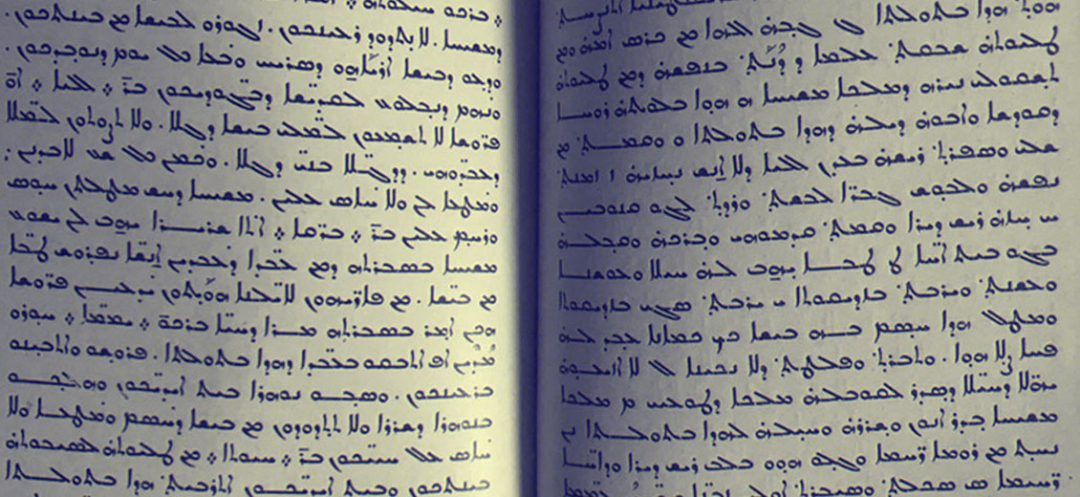
Literature upholds its rights against the myth behind the notion that Syriac died out after the Middle Ages, or was never more than a liturgical language confined to a few solitary monks in Mount Lebanon. The 17th, 18th and even the 19th and 20th centuries uncover a vast wealth of Syriac Maronite literary production, encompassing both the profane and sacred realms.
The alleged absence of profane Maronite literature in Syriac is often cited as proof that this language was never used beyond liturgical purposes. Some frequently point to the 11th-century translation of the Maronite Nomo-Canon into Arabic by Bishop David as proof that Mount Lebanon was Arabic-speaking ever since that time. However, this work is an exception in the history of Maronite religious literature, one which was followed by a second millennium of Syriac-language productions. This literary activity was clearly never confined to the ecclesiastical realm.
Sleiman Achlouhi, 1270-1335
A significant collection of zajal has been passed down to us from a Maronite cleric of the 15th-16th century, Bishop Gabriel Barcleius (1447-1516). However, it is essential not to overlook Sleiman Achlouhi (1270-1335), the distinguished secular poet from Akkar. His works, comprising about 60 verses, are preserved within Manuscript 214 of the Vatican Library. Additionally, Sarguis of Smar-Jbeil is another prominent zajal composer from the 16th century. Their enduring recognition is attributed to their dedication to documenting this supposedly spoken and improvised literature.
Faced with surprising claims regarding the nonexistence of Maronite literature beyond religious or liturgical contexts, a young scholar, Joseph BouCharaa, embarked on a quest to uncover manuscripts in various libraries across Lebanon and occasionally in the West. He discovered around 60 Maronite authors, many of whom used the Syriac language to compose secular-themed texts, both in verse and prose. This count grows even further when including the texts by anonymous authors that he also successfully compiled.
Yet even more astonishing is the extending vitality of this language up until the mid-20th century (as we will see in the next article). Outside the realm of the Church and its liturgy, Maronites actively learned and used Syriac until Arabic was declared the official language in 1943 by Bechara el-Khoury. However, the teaching of the Syriac language went on in schools until the last teachers retired in the 1960s. They took with them the last writers and poets who were the bearers of a language that had survived two millennia and resisted the greatest invaders. Their language died of civilizational suicide, as Arnold Toynbee would say.
[gallery link="none" size="large" ids="264158,264159,264160,264161"]
Joseph Dahdah, 1670
Moving on to the 17th century, during the 1670s the writer and poet Yaoseph Dahdoho of Ain-Qoura (Joseph Dahdah of Aqoura) made his mark. His poem on knowledge and teaching was found in Manuscript 191 of the Deir-el-Banet monastery. The author identifies himself as hailing from Ain-Qoura (the cold spring), which was the name of present-day Aqoura. Although his text is written without vowels, he made sure to include them in his name, which he distinctly pronounces as Dahdoho.
It should be noted that in his manuscript, the introductory or explanatory information about the year, author and content is all in Syriac.
Joseph de Ban, 1679
The same pattern emerges in the introduction of the book by Faustus Nairon (Maronite scholar from Rome), titled Dissertatio de origine, nomine, ac religione Maronitarum. The author introduces the content of his work by mentioning in Syriac, "History of Saint Maron, the Maronites and their nation." He identifies himself forthwith as hailing from Qrito Ban dab Touro de Levnon (the village of Ban in the mountains of Lebanon). He also attributes the authorship of the introductory poem to a bannoyo (a person from Ban).
The year is 1679, and the author of this poem is Yaoseph Issaoui Bannoyo (Joseph of Ban). A passage from this long eulogy to Saint Maron specifically praises the cedars and mountains of Lebanon. The rhyme leverages the similarity between the words Moroun and mouroun (Maron and muron). The translation of these Syriac verses, based on the metric of Saint James, evolves into the following:
Among the cedars of Lebanon, Maron grew up,
Eloquent and spiritual cedars, watered by muron. Between cedars and eloquent cedars Maron grew up
Marvel not that cedars exhale muron’s scent,
For among those fragrant cedars, Maron grew up
The country of the cedars is indeed muron’s country
And the country of muron is indeed Maron’s country.
Patriarch Joseph Estephan, 1766-1793
Yoseph Estephan of Ghosta, elected to the Syriac Maronite patriarchal seat of Antioch in 1766, is celebrated for his exceptional mastery of the Syriac language. He is credited as the author of the history of Saint Marina of Qannoubine, printed out in 1905 by Léon Clugnet in Paris. His text, which is entirely in Syriac, is characterized by a fluid style and a rich vocabulary. This proves that 18th-century inhabitants of Mount Lebanon were still raging and understanding this skillfully penned language.
While being a hagiographic literature, this text is neither liturgical nor theological and falls within the realm of history. Therefore, the Syriac language was not only used for prayer but also for spreading knowledge and heritage.
Bishop Joseph Estephan, 1761-1822
Yaoseph Estephan (18th-19th century) was a master of the Syriac language and the nephew of the patriarch bearing the same name. Despite being a bishop, his writings were secular and included, among other things, praises for the Prince of Lebanon, Bashir II the Great.
He wrote a poem entitled Wolito (Lamentation), dedicated to his uncle, the patriarch, who passed away in 1793. This poem is found in manuscript Syr.058 of the Bibliothèque Orientale at Saint Joseph University in Beirut. The following can be read in folios 59 to 64:
The sound of Lebanon's tears reaches me,
In the heart of Ghosta, lamentations fill that day.
Better than incense and beautiful flowers, the ashes are honored.
Sprinkled and scattered on the heads of men and women.
And even more so, beyond any variety of species, they are honored.
Read more




Comments